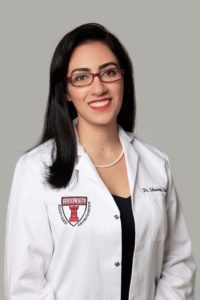Have you ever wondered what it takes to become an orthodontist in a foreign country? What are the similarities and differences in funding, educational pathway, treatment modalities and post-graduation career path? In this article, we dive in and compare orthodontic residency in the United States and the United Kingdom.
Funding for Orthodontic Treatment
In the United States, orthodontic treatment is funded via Medicaid, private insurance or out-of-pocket. Medicaid is a federally subsizided insurance to provide healthcare coverage to low-income families. However, due to stringent requirements to qualify for treatment, most orthodontic care in the US is paid for privately.
The United Kingdom (UK) has the National Health Service (NHS), which is a health service funded by the taxpayers. Every patient under the age of 18 is entitled to an orthodontic exam and allocated treatment depending on their Index of Orthodontic Treatment Need (IOTN). The IOTN is composed of two parts – the Dental Health Component (DHC) and the Aesthetic Component (AC). In order for a patient to qualify for treatment on the NHS they must score at least a 3 on the DHC and a 6 on the AC or higher. Adult patients on the other hand usually pay privately for orthodontic care.
Path to Become an Orthodontist
The path to becoming an orthodontist in the United States is quite different compared to the British system. In the US, most prospective orthodontists first complete a 4-year undergraduate degree. They then apply for dental school, which is another 4 years of education. After completing dental school, prospective orthodontists apply for post-graduate residency programs. These can range from a certificate in orthodontics (typically 2 years), a masters (3 years) or a doctorate degree (4 years). After graduating from residency, orthodontists can choose to pursue a craniofacial fellowship which delves more heavily into the treatment of cleft lip/palate and syndromic patients. The path to becoming an orthodontist may take anywhere from 10-14+ years after high school. After graduating from residency, orthodontists can choose to become board certified by taking a written, clinical and oral exam offered through the American Board of Orthodontists (ABO).
In the UK, high school education includes an extra year termed grade 13 where applicants undertake entrance exams called “Advanced level exams or A-Levels.” These exams hold the equivalence of first year university courses. Based on their grades in these exams, they are allowed admission straight into dental school, which is a 5-year program.
When applying to Orthodontic Specialty Training in the UK, applicants must have completed their Bachelor of Dental Surgery (BDS or BChD). They are able to apply to specialty training once they have at least 24 months of experience post-BDS qualification. Applicants should have also completed their Dental Foundation Training. At the end of this training, they will receive their Performer Number, which allows them to work in the UK NHS. Usually applicants will then take on Dental Core Training (DCT). The applicant can also spend time in dental practice and does not necessarily have to embark on a DCT pathway but must be able to show equivalent competencies.
Orthodontic training in the UK is a three-year program which will train to a specialist level. A specialist can then continue further training for two more years to reach the consultant level. This type of training is known as Post Completion Certification of Specialist Training or Post CCST. Orthodontic consultants usually work in hospitals and deal with more complex orthodontic treatment such as orthognathic surgery, hypodontia, craniofacial Anomalies, sleep Apnoea and other types of treatment. They are also involved in teaching and management within hospital or university departments. But they can also work in private practice.
To practice as a specialist in the UK, the dentist should have undertaken specialist training in a recognised and accredited program, pass the Membership to Orthodontics Examination (MOrth) through the Royal College of Surgeons (RCS) and the dentist must also be added onto the Specialist List with the General Dental Council (GDC).
Educational Funding
Educational funding in the US typically comes from either government-sponsored student loans, which must be repaid with interest, or private funding. The amount of debt incurred ranges greatly depending on whether the orthodontist attended public or private dental schools. However, it is not uncommon to see graduating orthodontist with over $500,000 in student loans.
Orthodontic trainees in the UK are NHS employees who undertake further post graduate qualifications as part of their training. They are paid a salary but usually fund their own university fees privately. Trainees can self-fund this part of their education or apply for personal loans from financial institutions such as banks or government bodies. England, Ireland, Wales, and Scotland each have their own student loans service which oversees funding for undergraduate and postgraduate study. However, not all applications for will receive funding from a government body depending on their individual application together with their financial and personal circumstances.
Treatment Modalities
In the US orthodontic education, many different treatment modalities are taught. In terms of treatment modalities, it seems like many US trained orthodontists lean more heavily towards the non-extraction treatment and fixed appliance therapy.
The debate in the UK between an extraction or non-extraction treatment has been going on for many years. Ultimately, the decision to extract or not extract is always case dependent but this have caused some controversy. Orthodontists in the UK also use a lot more removable functional appliances e.g. Clarks Twin Block, whereas internationally fixed functional appliances e.g. Herbst are more popular.
What students do upon graduation
In the US, orthodontists either can work in private practice as an associate, buy into a practice, work in corporate dentistry or pursue academia. Given the amount of student loans which need to be repaid, it is more common for newly graduated orthodontists to work in private practice.
In the UK, once a trainee has completed their specialty training, they can apply for Post-CCST, work in specialist orthodontic practice or a mixture of private practice and hospital-based practice. Some Post-CCST positions can be taken up on a part time basis. Some Post-CCST posts are also mainly research based. For these programs, the trainee will have more time allocated to research rather than clinical practice or other educational activities.
Shaima Tabari, BChD, DMSc candidate, Harvard School of Dental Medicine & Kirpal Singh Benawra BChD, MFDS
Shaima Tabari grew up in Dubai, U.A.E where she attended Choueifat high school. For her undergraduate degree in Pre-Med she attended the University of Toronto in Canada. She completed her dental training at the University of Leeds in the United Kingdom and her Craniofacial fellowship at the University of Pacific Arthur A. Dugoni School of Dentistry in San Francisco, CA. She is currently undertaking her final year of Orthodontic residency DMSc candidate where her doctorate research project focuses on the role of Obstructive Sleep Apnea in Orthodontic Patients. In addition to earning degrees from as many countries as possible, she enjoys skiing and horse riding and traveling (for fun not school).
Kirpal graduated from the University of Leeds in 2013 with a BA in Biomedical Ethics and a Bachelor of Dental Surgery. After graduating he spent two years as a General Professional Trainee in Newcastle Dental Hospital and in a general dental practice. He then completed his Dental Core Training in Oral and Maxillofacial Surgery for 12 months including on call duties. Currently he is a second year trainee in Orthodontics at Glasgow Dental Hospital and Forth Valley Royal Hospital which are both located in Scotland.


